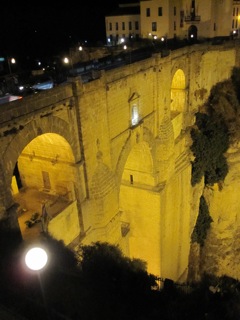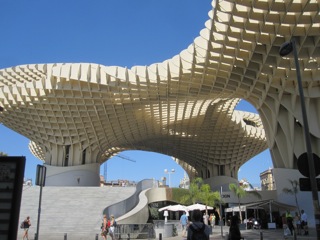Wednesday13th Our last day in Lisbon included a hop on/hop off trip on the river which we took on the “Yellow Boat” to Belem to see the Tower, Maritime Museum and Monastery of St. Jerome. Belem Tower was built by King– in 14.. on the river bank as a look out/gun emplacement guarding Lisbon. The Maritime Museum tells the naval history of Portugal as well as displaying many royal barges and boats. As are all Catholic Monasteries and cathedrals, St Jerome was very elaborate. The architecture was quite inspiring. It holds the tomb of Vasco de Gama. A quiet dinner in the hotel.
Thursday 14th An early call as we left the hotel at 6.30am for the airport and flight to Malaga. We flew over farmland and mountains. Fabulous views. Our taxi was waiting for us for the trip to Ronda about an hour and a half through landscapes of fieads, valleys and rocky mountains. When our room was ready we unpacked then took a walk across the New bridge (350 years old) to the old town. Our room was large with 3 doors each leading onto 3 small balcony, looking over the ravine and stone bridge. Photo included. The old town consisted of many cobble-stoned alleys and plazas with cafes and churches. The area around the hotel included many narrow streets with cafes, clothing/leather stores and the usual tourist shops. We visited the tourist centre to get info about some walks.
Friday 15th We took a walk across the Old Bridge, a narrow stone bridge built during 1300′s, to the Arab Baths. The baths are the best preserved in Europe and has a great display and video presentation on the history and use of the baths. we continued walking along a narrow path outside the city walls to the southern end of the city. This gave a wonderful view of the ancient city walls and fortifications. Walked to the bus station to book bus for Sunday to Seville.Late in the afternoon we took a tour of the Bull Ring. Its the best preserved and biggest in Spain, and had excellent displays and audio description of equine history and equipment and bull fighting. Bullfights are still held in the arena, while across Spain bullfighting is a very divisive issue.
Saturday 16th The weather throughout has been fine and sunny. We visited the Museo Palace de Mondragon – Palace to a Moorish King in 13th century. The Palace houses a great exhibition of the Ronda region from Neolithic times to present. It is one of the best museums we have encountered. The building has been well preserved with 3 architectual styles – Moorish, Jewish and Christian. Before lunch we took a walk down a steep and rather precarious path under the New Bridge. The afternoon we went to the Museo Unicaja Joaquim Peinado – dedicated to Peinado’s art from 1920′s to 1970′s. It also housed sketches by Piçacsso, a good friend of Peinado (the former born in Malaga, the latter in Rondo) . An impressive exhibition. We then walked to the southern exit of the old city to walk around the base of the walls on the western side. The road was steep and cobble stoned. After about 45 mins we stopped at a small hotel at the base of the cliff for coffee. The sheer cliffs are 120 m high. We took a very steep path back up towards the bridge that joined part of the path taken yesterday. Dinner was at a hotel overlooking the cliffs towards the mountains.
Sunday 17th A walk through a park along the cliff top before catching 1pm bus to Seville – a one and 3/4 hour trip. Our hotel in situated at the edge of the old town of Seville and is a series of old houses, converted into hotel accommodation and connected by corridors and small enclosed plazas and even a tunnel under a road to connect the two main sections . The old styles have been preserved and restored – it certainly has ‘character” while very comfortable with all the mod-cons. Took a walk and visited the Cathedral. Again very elaborate with very high ceiling and massive Gothic arches, gold altars and wood-panelled central choir stalls. It also housed the elaborate tomb of Christopher Columbus. The outside garden, though within the Cathedral walls, was planted with orange trees.
Monday 18th We arrived early for the opening of the Real Alcazar at 9.30 as only 750 visitors are allowed in each day. Its the oldest Royal Palace still in use in Europe. It has its origins from 6th century and has been well preserved with stunning Islamic tiling, painted and carved ceilings and walls. The gardens are beautiful, sculptured with many fountains in small courtyards. It was declared a World Heritage site in 1987. We spent 3 and a half hours there. Then a walk through Seville’s central shopping area. Nearby was the Metropol Parasol, said to be the largest wooden structure in the world. It towered like 3 sails above the plaza and street.


